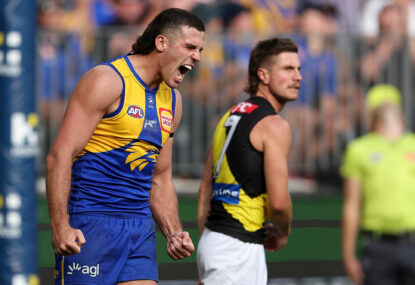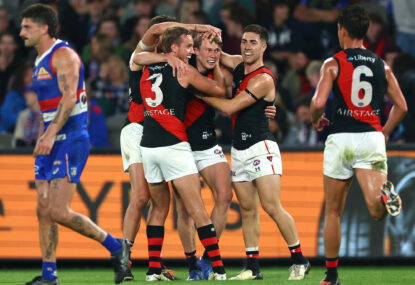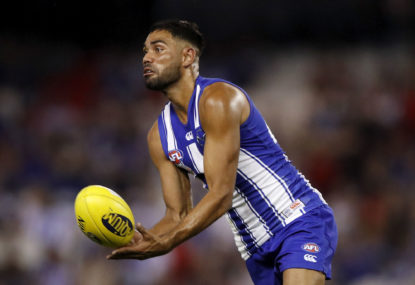Last Thursday it was revealed that 34 current and former Essendon players would be issued with ‘show cause’ notices by the Australian Sports Anti-Doping Authority (ASADA), with regard to their alleged use of banned peptide thymosin beta-4 (TB4).
With that announcement many believed the saga that has engulfed Essendon and the AFL would be drawing to a conclusion.
Yet in the days since it has become obvious that nothing could be further from the truth.
Personally, I have delayed writing about the issue for various reasons.
One is that I am a layman when it comes to the ASADA code. It is certainly not my place to determine what the players may have done wrong, nor what punishment they should face.
Like most passionate football followers, though, I have more questions than answers and I feel I need to ask them.
1. Why did Essendon self-report?
On February 5 last year Essendon went to ASADA to report their 2011 and 2012 supplement program.
Two days later a press conference was held in Canberra to announce findings of a report by the Australian Crime Commission (ACC). The report dealt with corruption in sport, specifically widespread doping and links to organised crime.
Present at that event were the heads of the ACC and ASADA, the federal justice minister, the federal sports minister and CEOs of the major Australian sporting organisations. Included among them was, of course, then-AFL CEO Andrew Demetriou.
Reports of a tip-off from Demetriou to then Essendon chairman David Evans have been denied. So why did Essendon feel the need to report their supplement regime to ASADA, especially at that time?
Without a tipoff they would have had no knowledge of intelligence gathered during the compiling of the ACC report.
One could argue that they themselves thought they may have done something outside the rules and wanted to get on the front foot. The events of the past week, though, have shown that altruism is not one of their strong suits.
It doesn’t take an ardent conspiracy theorist to believe they had information given to them from someone outside the football club that they may be the target of an investigation.
2. Why did the AFL insist on a joint investigation?
This question is much easier to answer. The AFL is a behemoth very much used to getting its way. An investigation conducted solely by ASADA would have taken all power away from the AFL and, as we are well aware, would have been incredibly lengthy.
The AFL were loathe to have any distractions during the finals series and needed this issue put to bed before September last year. It would seem that they had their minds made up as to what punishment they would hand out to Essendon well in advance.
When they asked ASADA for an interim report in August it contained very little in the way of actual breaches of the anti-doping code.
The AFL felt they did, however, have enough evidence of poor governance on the part of Essendon to ban them from the finals, suspend James Hird and Dr Bruce Reid, and fine Mark Thompson and the club, as well as imposing crippling draft penalties.
As far as the AFL were concerned the matter for their part had been dealt with.
3. Why did Essendon insist that James Hird accept a 12-month suspension?
When James Hird arrived at Essendon as coach for the 2010 season it was heralded as a return of the golden child. There are few in the history of this football club whose playing career compares to that of Hird.
By the end of 2013, Hird was seen as a liability. According to official findings at this point it was he alone that masterminded and implemented the controversial supplements program.
Essendon, particularly current chairman Paul Little, have stressed their concern for the welfare of their players. Why, then, has that concern not extended to the coach? The club seemed all too willing to throw him under the bus and take the fall for all involved.
This attitude has extended even into this season with senior officials at the club effectively telling him to pull his head in or risk returning to the job for which he is contracted next year and beyond. All the while Hird has been overseas, unseen and unheard.
There is a vocal section of Essendon supporters that believe the return of James Hird will bring with it an airing of the truth. I believe that Essendon and the AFL would be hoping against hope that is not the case or this drama could get worse before it gets better for everyone.
4. Why did Essendon wait to begin court proceedings against ASADA?
Paul Little has stated that Essendon have sound legal advice that the joint investigation is unlawful at its core. They submit that there is nothing on ASADA legislation that allows it to conduct an investigation in tandem with another outfit.
More educated legal minds than mine appear to differ in opinion on this point. Obviously ASADA rely on the cooperation of the governing bodies of sports.
To what degree that cooperation is seen as legal is up for debate, but if Essendon has such faith in their advice they could’ve brought proceedings forth months ago.
Essendon and the AFL have been vocal in their complaints about the length of this investigation. All the while they have had it in their power to bring it to a halt, or at least attempt to.
To wait until ‘show cause’ notices have been issued shows either a misplaced confidence against prosecution, or a major dropping of the ball.
Perhaps their confidence is due in some part to the belief that they were being investigated for the use of AOD9604 and not TB4. A charge of using AOD would be much easier to fight as it was not banned at the time they allegedly used it. TB4, on the other hand, has been banned for some time.
One thing is for certain, and that is that these legal proceedings will only serve to lengthen the already unruly saga.
5. Why is ASADA offering Essendon players a reduced penalty?
New ASADA boss Ben McDevitt appeared on almost every media outlet in the country last week stating that the Essendon players could serve a reduced sentence if they admit fault in this case.
At the risk of over dramatising, this sounds like a scene straight from Law and Order.
I can imagine Elliot Stabler saying, “just tell us how it went down and we’ll make it worth your while”. When that happens on TV, though, it usually means they don’t have enough evidence.
I can’t imagine that after 16 months and hundreds of interviews that ASADA would issue ‘show cause’ notices without gathering sufficient evidence. Surely, after this length of time, if they weren’t confident of a finding in their favour they would just declare the investigation closed.
If they do have the required evidence, perhaps they are just trying to make it easier on the players.
If they don’t have enough evidence, God help them. Essendon will unleash hell upon them and their credibility will be in tatters.
There are several more questions that need answers and hopefully we’ll have them in due course. For now though, we must sit back and watch them fight it out. With every revelation the saga deepens and the issue becomes greyer.
My hope is that someone really has the players’ best interests at heart. We can be fairly certain that not one of them knowingly or willingly took a performance enhancing substance, yet it is they who will pay the highest price.
A two-year ban for an athlete in their physical prime is devastating.



































































































